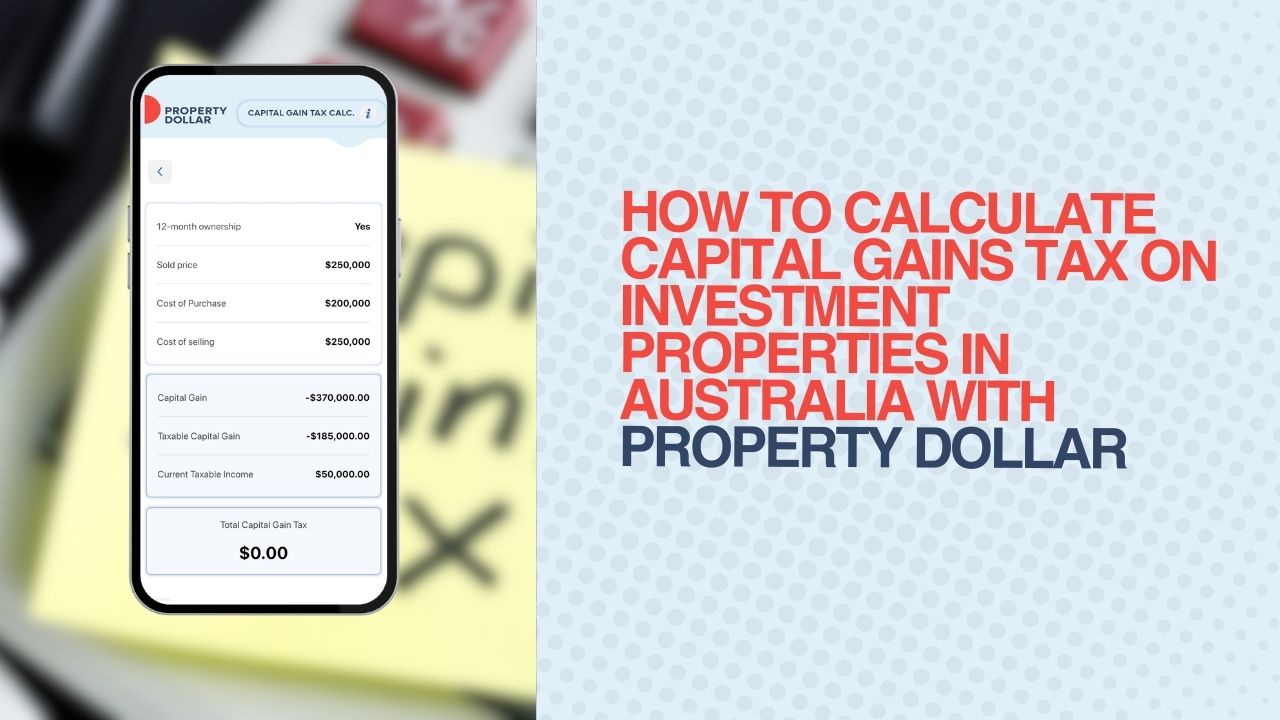How to Calculate Capital Gains Tax on Investment Properties in Australia | Property Dollar
- November 1, 2024

Are you considering selling your investment property in Australia and want to know how much capital gains tax (CGT) you might owe? Calculating CGT can be a bit tricky, especially with all the components that contribute to the final amount. This guide will walk you through the essential steps for calculating capital gains tax on your investment property and help you better understand your potential tax obligations.
Please note: This blog is not financial advice. Always consult a qualified financial advisor or accountant for accurate tax guidance and personalised advice on your property investments.
1. Understanding Capital Gains Tax (CGT)
Capital Gains Tax (CGT) is the tax payable on the profit you make when you sell an investment property for more than you originally paid. In Australia, CGT is part of your income tax and is applied to the capital gain (the profit) you make on the sale. For investment properties, CGT can become a significant amount, so calculating it accurately is essential for budgeting and planning.
2. Steps to Calculate CGT on an Investment Property
To get started with CGT calculation, you’ll need the following information:
- Date of Purchase and Date of Sale: Knowing these dates helps determine if you’re eligible for a 50% CGT discount. Properties held for over 12 months are eligible for this discount.
- Sales Price: This is the amount you received for the property at sale.
- Purchase Price: The initial amount you paid for the property.
Once you have these details, follow these steps to calculate CGT.
Step 1: Calculate the Gross Capital Gain
The gross capital gain is calculated by subtracting the “cost base” (the initial purchase cost and related expenses) from the sales price.
Cost Base Calculation
The cost base includes several expenses:
- Purchase Price: The original price you paid for the property.
- Stamp Duty: Paid at the time of purchase, typically found on your settlement statement.
- Legal Fees on Purchase and Sale: These can include lawyer and conveyancer fees.
- Commission on Sale: Any fees paid to a real estate agent for selling the property.
- Non-Deductible Holding Costs: Includes any costs you couldn’t deduct during ownership, such as certain registration fees, council rates, and other compliance reports.
Example: If you purchased the property for $500,000 and incurred an additional $21,425 in expenses (stamp duty, legal fees, etc.), your total cost base would be $521,425.
Gross Capital Gain Calculation
If you sold the property for $1,000,000, your gross capital gain would be:
Sales Price−Cost Base=$1,000,000−$521,425 = $478,575
Step 2: Apply the CGT Discount (If Applicable)
In Australia, if you’ve held the property for more than 12 months, you can reduce your gross capital gain by 50%. This is known as the CGT discount.
Net Capital Gain=Gross Capital Gain×50%
Using our example:
$478,575×50% = $239,287.50
So, your net capital gain, after applying the discount, is $239,287.50.
Step 3: Add the Net Capital Gain to Your Taxable Income
The final step is to add this net capital gain to your taxable income for the year. Your total income, including the capital gain, will determine your tax rate. For instance, if the net capital gain places you in a higher tax bracket, you may end up paying a substantial amount of tax.
If you’re in the highest tax bracket, you’d pay around 47% on your capital gains, so:
Capital Gains Tax Liability = $239,287.50×47% = $112,465
Factors That May Affect Your CGT Calculation
While this example covers a simple CGT calculation, other factors may influence the final tax amount:
- Property Improvements: Any capital improvements made to the property can adjust your cost base.
- Personal Use: If the property was used as your primary residence at any point, you may be eligible for certain exemptions.
- Joint Ownership: If the property has multiple owners, CGT liability is shared proportionately.
Always consult an accountant to navigate these complexities.
Using Property Dollar’s Capital Gains Tax Calculator
Calculating CGT manually can be complex. That’s why Property Dollar has introduced a Capital Gains Tax Calculator designed specifically for Australian property investors. By entering details such as purchase price, sales price, and holding duration, you can receive an instant estimate of your capital gains tax obligation. It’s a simple way to gain clarity on potential tax liabilities before making any selling decisions.
Plan Ahead with Property Dollar: Alongside the CGT Calculator, Property Dollar offers a comprehensive Property Market Value Tracker to help you keep track of property values in real-time, giving you better control over your investments. Download the app now and take charge of your property portfolio with Property Dollar.
Disclaimer: The information provided in this blog is general in nature and not intended to be personalized financial advice. Please consult a financial advisor before making any decisions regarding your finances.




